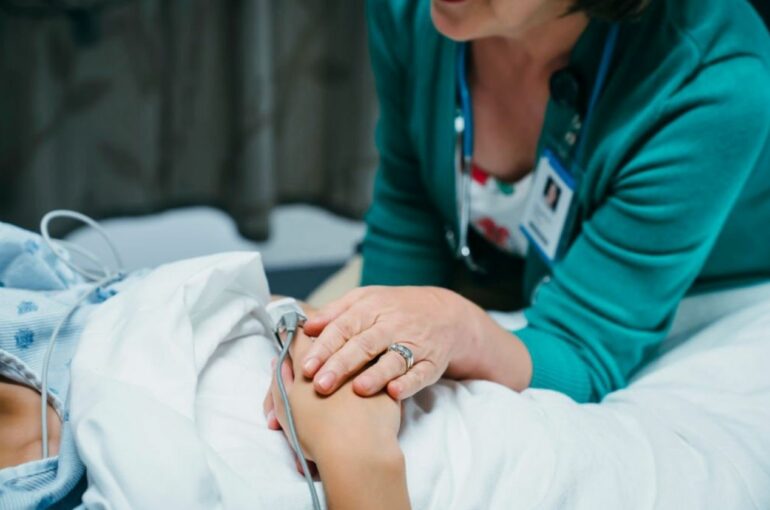Are you likely to receive better care if the specialist treating you knows your primary care physician?
The answer appears to be yes, according to new research from Harvard Medical School published Jan. 3 in JAMA Internal Medicine.
Patients under the care of specialists who trained with the patients’ primary care physicians (PCPs) reported being treated with a more concerned manner, receiving clearer explanations, and experiencing greater engagement in shared decision-making, among other benefits, the study found.
The findings suggest that strategies that encourage the formation of stronger peer relationships among physicians could lead to significant gains in the quality of patient care, the authors said.
The analysis is based on electronic health records of more than 8,600 patients referred by their PCPs to see a specialist between 2016 and 2019. All the referrals occurred in a large academic health system. The researchers compared patients’ ratings of specialist care between two groups of patients—those seen by a specialist who trained with the patient’s PCP in medical school or postgraduate programs, and patients of the same PCP seen by a specialist who did not train with their PCP—while controlling for specialist performance for patients of other PCPs when such co-training ties were absent.
Importantly, the researchers examined referrals that were distributed to specialists by a scheduling system rather than referrals where PCPs requested specific specialists. In this way, the team could isolate the causal effect that we would see if patients were randomized to specialists.
Harvard Medicine News spoke about the implications of the findings with study first author Maximilian Pany, an MD-Ph.D. candidate at HMS and Harvard Business School, and senior author J. Michael McWilliams, the Warren Alpert Foundation Professor of Health Care Policy at HMS and a general internist at Brigham and Women’s Hospital.
This interview was edited for length and clarity.
HMNews: What sparked your interest in the interplay between patient satisfaction and prior connections between the primary care physicians and specialists who treat them?
Pany: Interactions between PCPs and specialists are a bedrock of medicine, and specialty referrals are how a lot of downstream patient care gets shaped. Given the communication and collaboration inherent in caring for referred patients, we were wondering whether prior PCP–specialist relationships influence that care, especially as experienced by patients. Not only are patient experiences an important dimension of quality of care, but we thought they may also be responsive to physician efforts to demonstrate their professionalism given the medical profession’s emphasis on patient-centered care.
HMNews: What aspects of care improved?
Pany: We found that patients referred to specialists by co-trainees rated their specialists higher on almost all dimensions we examined. This includes not only interpersonal communication—such as friendliness, quality of explanations, and demonstrated concern—but also involvement in shared decision-making, use of understandable language, and amount of time spent. In addition to higher patient ratings, co-training elicited changes in specialists’ medication-prescribing behavior, which suggests an impact beyond (the very important!) patient perception.
HMNews: What do you think accounts for this difference in performance?
Pany: We believe the driving mechanism at play is that specialists are aware that PCPs can observe aspects of their care—through reading clinical notes and talking to patients, for example. The existence of a strong peer relationship may remind specialists of commonly valued precepts of professionalism or otherwise motivate them to change care in ways that have a positive impact on patients.
HMNews: Was this finding in any way surprising or did you suspect this might be the case?
Pany: While it wasn’t surprising in theory, we were surprised by the magnitude of the impact we found. I suspect that most of us have experienced situations, not necessarily related to medicine, in which we wanted to excel because we knew familiar peers would observe us. If the presence of peers whose opinion we care about motivates better performance in, say, pickup soccer games, why wouldn’t it in a professional context such as medicine? It’s a fundamentally human phenomenon.
HMNews: What are the broader implications of these findings?
McWilliams: What we think we uncovered here is the power of peer relationships in medicine, which has major implications for how care is organized and how physicians are, loosely speaking, managed. During training, we physicians form strong relationships with other physicians, but then we often practice in isolation—this despite the fact that most of us now work in employed groups and use advanced information and communication systems that should make it easier for us to interact. Essentially, we’ve grouped and electronically connected physicians, but we haven’t leveraged what physicians can offer when grouped or connected.
I’d say that there is another high-level policy implication of the dramatic effect we found: What drives physicians to excel is primarily not money. Policymakers have been trying for years to try to pay for quality, with little success. What our study suggests is that physicians’ intrinsic motivation runs deep—it’s there but often undermined by our system. We need to do a better job of tapping into it.
HMNews: How should these findings be applied in practice to move the needle on physician performance? How do we operationalize them?
McWilliams: There are a bunch of strategies, and I think we can get very creative here. One is team care in which physicians can observe each other’s decision-making and lead by example. Another is to make physicians more visible to each other when they collaborate on patient care—for example through e-consults, virtual curbside consults, or other back channels that breed familiarity. Another is to use modes of collegial peer review such as group case discussions more often and more effectively.
Imagine knowing that any patient encounter or surgical case could be randomly selected for discussion over lunch with valued colleagues. We could also identify exemplars and redeploy them as coaches. And more generally, do anything that makes the practice of medicine less lonely—for example, move the workstations out of the exam rooms to a communal space where physicians will naturally interact with each other.
HMNews: Any caveats or limitations you want to highlight?
Pany: In our study, co-training was a proxy for physician–peer relationships but co-training ties are very likely not the only source of physician–peer effects. To what extent the effect of co-training generalizes to other forms of physician–peer interactions remains a topic for future work we are excited about.
More information:
JAMA Internal Medicine (2023). jamanetwork.com/journals/jamai … ainternmed.2022.6007
Provided by
Harvard Medical School
Citation:
When doctors know each other: Patients benefit when specialists know referring physicians, research says (2023, January 3)



